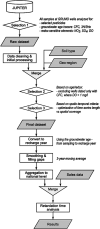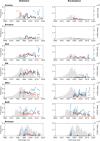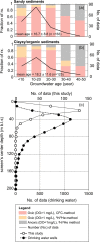National Assessment of Long-Term Groundwater Response to Pesticide Regulation
- PMID: 36162811
- PMCID: PMC9583610
- DOI: 10.1021/acs.est.2c02261
National Assessment of Long-Term Groundwater Response to Pesticide Regulation
Abstract
Quantitative assessments of long-term, national-scale responses of groundwater quality to pesticide applications are essential to evaluate the effectiveness of pesticide regulations. Retardation time in the unsaturated zone (Ru) was estimated for selected herbicides (atrazine, simazine, and bentazon) and degradation products (desethylatrazine (DEA), desisopropylatrazine (DIA), desethyldesisopropylatrazine (DEIA), and BAM) using a multidecadal time series of groundwater solute chemistry (∼30 years) and herbicide sales (∼60 years). The sampling year was converted to recharge year using groundwater age. Then, Ru was estimated using a cross-correlation analysis of the sales and the frequencies of detection and exceedance of the drinking water standard (0.1 μg/L) of each selected compound. The results showed no retardation of the highly polar, thus mobile, parent compounds (i.e., bentazon), while Ru of the moderately polar compounds (i.e., simazine) was about a decade, and their degradation products showed even longer Ru. The temporal trends of the degradation products did not mirror those of the sale data, which were attributed to the various sale periods of the parent compounds, sorption of the parent compounds, and complex degradation pathways. The longer Ru in clayey/organic sediments than in sandy sediments further confirmed the role of soil-specific retardation as an important factor to consider in groundwater protection.
Keywords: groundwater; lag time; national assessment; pesticides; retardation time; transport time.
Conflict of interest statement
The authors declare no competing financial interest.
Figures





Similar articles
-
Factors controlling spatial and temporal patterns of multiple pesticide compounds in groundwater (Hesbaye chalk aquifer, Belgium).Environ Pollut. 2017 Apr;223:185-199. doi: 10.1016/j.envpol.2017.01.012. Epub 2017 Jan 27. Environ Pollut. 2017. PMID: 28139324
-
Spatial distribution of triazine residues in a shallow alluvial aquifer linked to groundwater residence time.Environ Sci Pollut Res Int. 2017 Mar;24(8):6878-6888. doi: 10.1007/s11356-016-7224-x. Epub 2016 Jul 22. Environ Sci Pollut Res Int. 2017. PMID: 27448811
-
Occurrence of Banned and Currently Used Herbicides, in Groundwater of Northern Greece: A Human Health Risk Assessment Approach.Int J Environ Res Public Health. 2022 Jul 21;19(14):8877. doi: 10.3390/ijerph19148877. Int J Environ Res Public Health. 2022. PMID: 35886730 Free PMC article.
-
Long-term leaching through clayey till of N,N-dimethylsulfamide, a Persistent and Mobile Organic Compound (PMOC).J Contam Hydrol. 2023 Jul;257:104218. doi: 10.1016/j.jconhyd.2023.104218. Epub 2023 Jun 19. J Contam Hydrol. 2023. PMID: 37356422 Review.
-
Assessment of risks to listed species from the use of atrazine in the USA: a perspective.J Toxicol Environ Health B Crit Rev. 2021 Aug 18;24(6):223-306. doi: 10.1080/10937404.2021.1902890. Epub 2021 Jul 5. J Toxicol Environ Health B Crit Rev. 2021. PMID: 34219616 Review.
Cited by
-
Development of a Multifaceted Perspective for Systematic Analysis, Assessment, and Performance for Environmental Standards of Contaminated Sites.ACS Omega. 2024 Jan 11;9(3):3078-3091. doi: 10.1021/acsomega.3c05187. eCollection 2024 Jan 23. ACS Omega. 2024. PMID: 38284061 Free PMC article. Review.
-
Pesticide Prioritization by Potential Biological Effects in Tributaries of the Laurentian Great Lakes.Environ Toxicol Chem. 2023 Feb;42(2):367-384. doi: 10.1002/etc.5522. Epub 2022 Dec 23. Environ Toxicol Chem. 2023. PMID: 36562491 Free PMC article.
References
-
- Directive 2006/118/EC of the European Parliament and of the Council of 12 December 2006 on the Protection of Groundwater against Pollution and Deterioration. Off. J. Eur. Union 2006, 372, 19–31.
-
- Directive 2000/60/EC of the European Parliament and of the Council, of 23 October 2000, Establishing a Framework for Community Action in the Field of Water Policy. Off. J. Eur. Communities 2000, 327, 1–73.
-
- Mohaupt V.; Völker J.; Altenburger R.; Birk S.; Kirst I.; Kühnel D.; Küster E.; Semerádová S.; Šubelj G.; Whalley C.. Pesticides in European rivers, lakes and groundwaters-Data assessment. https://www.eionet.europa.eu/etcs/etc-icm/products/etc-icm-report-1-2020... (accessed May 23, 2022).
-
- Thorling L.; Nilsson B.; Møller I.; Bollmann U. E.; Johnsen A. R.; Troldborg L.. Udvikling Af Metode Til Vurdering Og Gennemførelse Af Vurderinger Af de Danske Grundvandsforekomsters Kemiske Tilstand for Pesticider (Development of a Method for Assessment and Implementation of Assessments of Groundwater Chemical Status for Pesticides for the Danish Groundwater Bodies) Dokumentationsrapport; De Nationale Geologiske Undersøgelser for Danmark Og Grønland Klima-, Energi-Og Forsyningsministeriet, 2021.
-
- Skaarup C.; Wodschow K.; Voutchkova D. D.; Schullehner J.; Raaschou-Nielsen O.; Andersen H. R.; Hansen B.; Ersbøll A. K. Geographical Distribution and Pattern of Pesticides in Danish Drinking Water 2002–2018: Reducing Data Complexity. Int. J. Environ. Res. Public Health 2022, 19, 82310.3390/ijerph19020823. - DOI - PMC - PubMed
Publication types
MeSH terms
Substances
LinkOut - more resources
Full Text Sources
Medical
Miscellaneous

